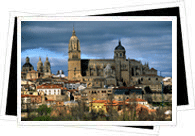 Salamanca (UNESCO World Heritage City)
Salamanca (UNESCO World Heritage City)
Located in the southwest corner of Castilla y León, Spain's "golden city" - so called for the golden sandstone used in the construction of city's buildings - is an architectural wonderland brimming with monumental buildings, fascinating museums, two cathedrals, beautiful churches and magnificent plazas. Its university - the oldest in Spain and one of the oldest in the world - was founded in 1218 by King Alfonso IX and grew to become one of the world's four intellectual "leading lights" along with the universities of Bologna, Paris and Oxford.
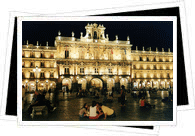 The city's importance as a seat of learning led to the architectural and cultural splendor that still reverberates through the city today. It's not a city living in the past however; you can pretty much classify Salamanca as one of the oldest young cities - or youngest old cities - in the world. The ancient streets and resplendent Renaissance buildings continue to host a vibrant student population that has sparked one of Spain's wildest nightlife scenes.
The city's importance as a seat of learning led to the architectural and cultural splendor that still reverberates through the city today. It's not a city living in the past however; you can pretty much classify Salamanca as one of the oldest young cities - or youngest old cities - in the world. The ancient streets and resplendent Renaissance buildings continue to host a vibrant student population that has sparked one of Spain's wildest nightlife scenes.
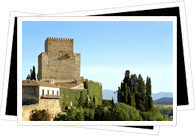 Ciudad Rodrigo
Ciudad Rodrigo
Situated in Castilla y León between Salamanca and the Portuguese border is the tranquil medieval town of Ciudad Rodrigo. Within the 16th century walls - which you can even walk on top of for a great view - is a fascinating town that has not changed all that much over the centuries. Follow its narrow, cobblestone streets to noble palaces, cute shops and welcoming plazas- perfect for kicking back and watching the laid-back Ciudad Rodrigo way of life unfold before you.
Check out the pockmarks left on the façade of the town's cathedral - Ciudad Rodrigo's architectural gem - by cannon balls during the War of Spanish Independence, when Spain finally took on a certain ambitious Frenchman named Napoleon Bonaparte. Admire the marvelous Romanesque doorway before heading inside, where you'll come across the prized choir stalls. Don't just pass by; the cathedral's choir is famous for the carvings on the chairs. You are guaranteed to be surprised at the satirical - and even downright scandalous - scenes depicted within such a religious institution!
<
Segovia (UNESCO World Heritage City)
While most people heading into Segovia have heard of its Roman aqueducts, few of them actually expect the sight of the monumental structure running right through the middle of the city. A stunning example of the architectural dominance of the Romans as far back as the first century, A.D., not even the tiniest bit of mortar was used; the construction of the aqueduct relies totally on the weight of the stones!
The rest of the city is loaded with monuments ranging from 14th century towers to noble palaces, elegant churches and Romanesque remnants, all of which helped to garner Segovia status as a UNESCO World Heritage City. The second of Segovia's landmarks - and one of the architectural jewels of Castilla y León - is the city's Alcázar. Built little by little between the 12th and 15th centuries, the castle is complete with towers, turrets, a keep, courtyards and even a plunging moat; one look at this incredible piece of architecture and you'll see why it is widely believed to be the inspiration for Walt Disney's emblematic Cinderella castle.
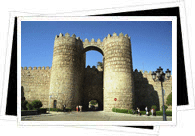 Ávila (World Heritage City)
Ávila (World Heritage City)
Acting like a photograph straight out of history, tranquil Ávila is one of Castilla y León's most treasured towns. Still entirely enclosed within the city's original defensive walls (a view that you can admire in its entirety from the Cuatro Postes viewpoint, located northwest of Ávila), the city boasts a noble, religious and architectural heritage that many cities can only dream of. The medieval walls, constructed between the 11th and 12th centuries, boast 88 watchtowers and eight grandiose gates. Within them you will find noble mansions mixed with monasteries, cathedrals and other religious institutions.
According to legend, the city was founded by one of Hercules' sons, but Roman gods and their offspring aren't Ávila's only local celebrities. Ávila was also the old stomping grounds of the 16th century's Saint Teresa of Ávila, a fact which infused the city with an important spiritual significance and subsequently led to its incredible architectural affluence.
León
Spreading out around its magnificent 13th century cathedral - one of the first and most important Gothic cathedrals in Spain - is León and its architecturally stunning Gothic quarter, where you can find an unbeatable mix of Romanesque and Gothic buildings and churches. Keep your eyes peeled for pilgrims on the Way of Saint James traipsing through León, one of the most important stops along the pilgrimage; you will see the gold scallop shells marking the way through the city.

A small cosmopolitan city of 165,000, León keeps up with modern Spain without losing its ancient and picturesque charm. Giving the ancient streets a "new" edge are more modern additions like the funky Castilla-León Museum of Contemporary Art (MUSAC), Modernisme giant Antoni Gaudí's Neo-Gothic "Casa de los Botines" and tons of parks perfect for a stroll. Once the sun sets and your day of tourism winds down, head to the city's happening nightlife zone, called the "Barrio Húmedo" (Wet Neighborhood) for the free-flowing beverages and energetic after-hours fun.
Zamora
Like most cities and towns throughout Castilla y León, Zamora grew and prospered as a fortress town on the line between the combatting Christian and Muslim fronts. Today, part of what makes Zamora - nicknamed the "Romanesque Museum" - so charming is that it doesn't see the same level of tourism as other cities in Castilla y León. The town is chock-full of medieval churches hailing from the 12th and 13th centuries, when a fervant wave of church-building formed Zamora's architectural core.
Zamora's cathedral, a mix of Romanesque and Gothic styles, boast ornate doorways, towers and turrets, while the nearby 10th-12th century castle retains its moat, keep, walls and medieval flavor. With a decidedly "old" atmosphere, Zamora is a great spot to wander around before enjoying the cafés and bars lining its streets and plazas.
Burgos
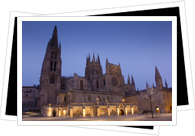 Founded in 884 AD as a strategic fortress against both the Muslims and the Spanish yet rival kingdom of Navarra, the compact city of Burgos has long been boosted by the Way of Saint James pilgrimage, along which it was a crucial stop. Defensive wall ruins, castles, fortifications, towers, city entrances and more speak volumes of the city's medieval glory, while a fascinating mixture of noble buildings, monasteries, palaces and gardens.
Founded in 884 AD as a strategic fortress against both the Muslims and the Spanish yet rival kingdom of Navarra, the compact city of Burgos has long been boosted by the Way of Saint James pilgrimage, along which it was a crucial stop. Defensive wall ruins, castles, fortifications, towers, city entrances and more speak volumes of the city's medieval glory, while a fascinating mixture of noble buildings, monasteries, palaces and gardens.
The Gothic cathedral is easily the pride of Burgos. The cathedral, which by the way also serves as the final resting place of Spain's legendary El Cid, is one of the great Gothic cathedrals not only of Castilla y León but also of the rest of Spain. The tightly-knit historical quarter spreading around it is guaranteed to enchant you with its stunning architecture, hidden nooks, winding streets, welcoming plazas and pretty promenades.
Covarrubias
Tucked into the extraordinarily beautiful and verdant Castilla y León countryside, this tiny village of only around 640 residents is one of the best examples of the traditional architecture typical of rural Castilla y León. A medieval vibe infuses the village with a quaint atmosphere that is only amplified by the ancient, timber-framed houses and a variety of 10th through 16th century constructions.
Covarrubias' biggest draw is the adobe houses framed with dark wood tracery that line the arcaded streets, making it seem as though you've been transported to another era. Other monuments include the 12th century palace now housing the Town Hall, the array of Gothic churches and the 10th century tower where - according to legend - a certain Doña Urraca was locked in by her father for having fallen in love with a shepherd.
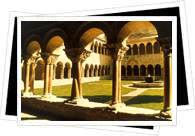 Santo Domingo de Silos
Santo Domingo de Silos
At first glance, Santo Domingo de Silos is just a tiny town set in rural Castilla y León. However, the town's fame quite literally skyrocketed during the 1990's when the monks of its Benedictine monastery recorded Gregorian chants. The recordings even made their way on to top music charts around the world!
The convent, principally Romanesque but with sections going all the way back to Visigoth times, boasts architecture, carvings, decoration and cloisters all considered to be masterpieces of the Romanesque era. If you're male (sorry ladies), consider renting a room in the complex for anywhere between three and ten days. You won't be alone though; along with being a popular option for travelers, around 25 monks still inhabit the ancient monastery, where you can go to the church to hear the enigmatic Gregorian chants for free.